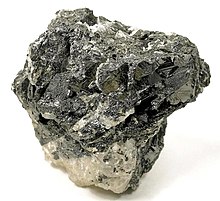Geikielite
Appearance
| Geikielite | |
|---|---|
 Crystals of geikielite from the Maxwell quarry, Chelsea, Outaouais, Québec, Canada | |
| General | |
| Category | Oxide mineral |
| Formula (repeating unit) | MgTiO3 |
| IMA symbol | Gk[1] |
| Strunz classification | 4.CB.05 |
| Crystal system | Trigonal |
| Crystal class | Rhombohedral (3) (same H-M symbol) |
| Space group | R3 |
| Unit cell | a = 5.05478(26) Å c = 13.8992(7) Å; Z = 6 |
| Identification | |
| Color | Black, ruby red uncommon; red internal reflections |
| Crystal habit | Tabular prismatic crystals, also as finely granular masses |
| Cleavage | Good on {1011} |
| Mohs scale hardness | 5 - 6 |
| Luster | Sub-metallic |
| Streak | Purplish brown |
| Diaphaneity | Opaque to translucent |
| Specific gravity | 3.79 - 4.2 |
| Optical properties | Uniaxial (-) |
| Refractive index | nω = 2.310 - 2.350 nε = 1.950 - 1.980 |
| Birefringence | δ = 0.360 - 0.370 |
| Pleochroism | Weak, O = pinkish red, E = brownish to purplish red |
| References | [2][3][4] |
Geikielite is a magnesium titanium oxide mineral with formula: MgTiO3. It is a member of the ilmenite group. It crystallizes in the trigonal system forming typically opaque, black to reddish black crystals.
It was first described in 1892[5] for an occurrence in the Ceylonese gem bearing gravel placers. It was named for Scottish geologist Sir Archibald Geikie (1835–1924).[4] It occurs in metamorphosed impure magnesian limestones, in serpentinite derived from ultramafic rocks, in kimberlites and carbonatites. Associated minerals include rutile, spinel, clinohumite, perovskite, diopside, serpentine, forsterite, brucite, hydrotalcite, chlorite and calcite.[2]
References
[edit]- ^ Warr, L.N. (2021). "IMA–CNMNC approved mineral symbols". Mineralogical Magazine. 85 (3): 291–320. Bibcode:2021MinM...85..291W. doi:10.1180/mgm.2021.43. S2CID 235729616.
- ^ a b Handbook of Mineralogy
- ^ Geikielite on Mindat.org
- ^ a b Geikielite on Webmineral
- ^ Fletcher, L. (1892). "Geikielite and Baddeleyite, Two New Mineral Species". Nature. 46 (1200): 620–621. Bibcode:1892Natur..46..620F. doi:10.1038/046620b0.
Further reading
[edit]- Ghiorso, Mark S. (1990). "Thermodynamic properties of hematite — Ilmenite — Geikielite solid solutions". Contributions to Mineralogy and Petrology. 104 (6): 645–667. Bibcode:1990CoMP..104..645G. doi:10.1007/BF01167285. S2CID 98522254.
- Reynard, B.; Guyot, F. (1994). "High-temperature properties of geikielite (MgTiO3-ilmenite) from high-temperature high-pressure Raman spectroscopy ? Some implications for MgSiO3-ilmenite". Physics and Chemistry of Minerals. 21 (7): 441. Bibcode:1994PCM....21..441R. doi:10.1007/BF00202274. S2CID 96095190.
- Baura-Peña, M. P.; Martínez-Lope, M. J.; García-Clavel, M. E. (1991). "Synthesis of the mineral geikielite MgTiO3". Journal of Materials Science. 26 (16): 4341. Bibcode:1991JMatS..26.4341B. doi:10.1007/BF00543648. S2CID 94170430.
- Robie, Richard A.; Haselton, H.T.; Hemingway, Bruce S. (1989). "Heat capacities and entropies at 298.15 K of MgTiO3(geikielite), ZnO (zincite), and ZnCO3 (smithsonite)". The Journal of Chemical Thermodynamics. 21 (7): 743. doi:10.1016/0021-9614(89)90058-X.
- Gieré, Reto (1987). "Titanian clinohumite and geikielite in marbles from the Bergell contact aureole". Contributions to Mineralogy and Petrology. 96 (4): 496–502. Bibcode:1987CoMP...96..496G. doi:10.1007/BF01166694. S2CID 86861792.
- Parthasarathy, G. (2007). "Electrical resistivity of nano-crystalline and natural MgTiO3−geikielite at high-pressures up to 8 GPa". Materials Letters. 61 (21): 4329–4331. doi:10.1016/j.matlet.2007.01.097.
- Mitchell, Jeremy N.; Yu, Ning; Sickafus, Kurt E.; Nastasi, Michael A.; McClellan, Kenneth J. (1998). "Ion irradiation damage in geikielite (MgTiO3)". Philosophical Magazine A. 78 (3): 713. Bibcode:1998PMagA..78..713M. doi:10.1080/01418619808241931.
- Chao, G. Y.; Hounslow, A. W. (June 1967). "Geikielite; a new Canadian occurrence". The Canadian Mineralogist. 9 (1): 95–100.
